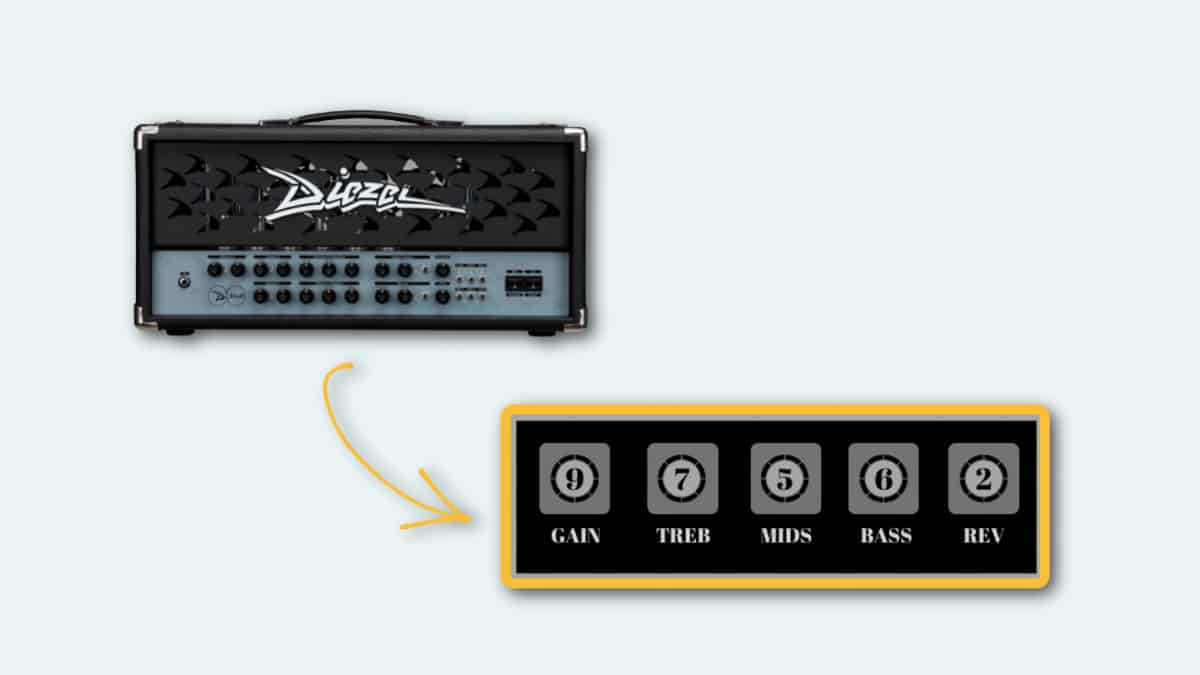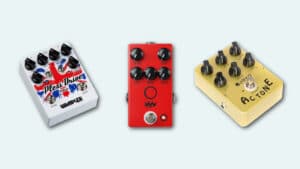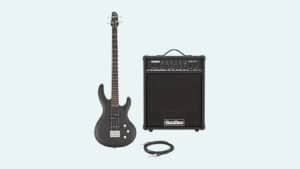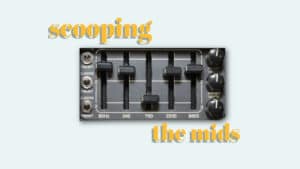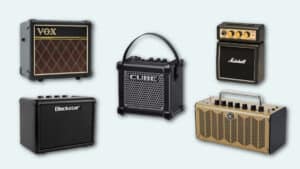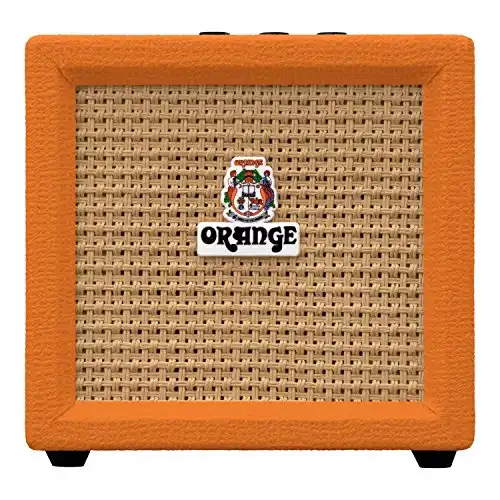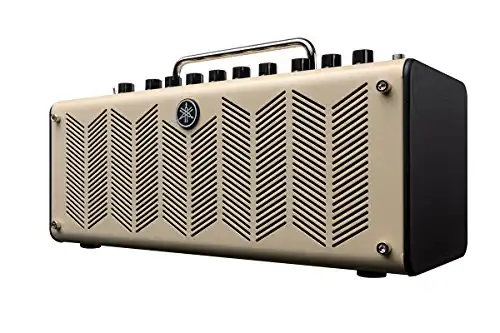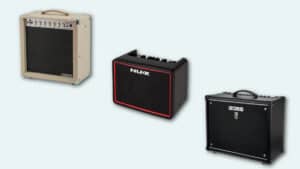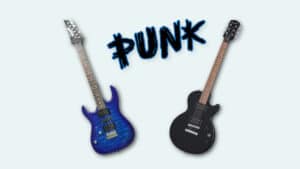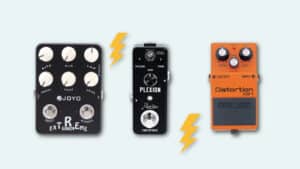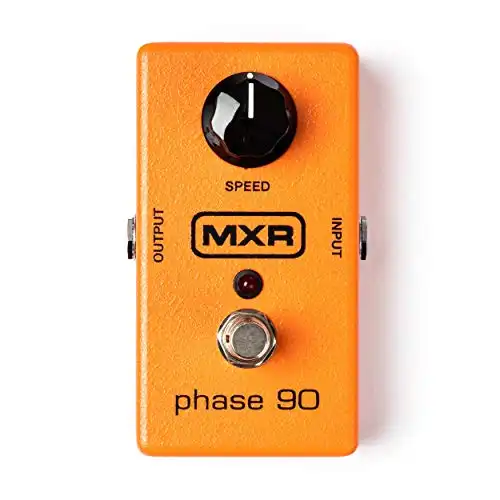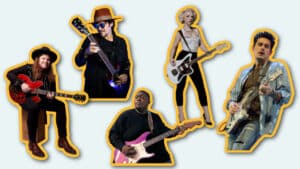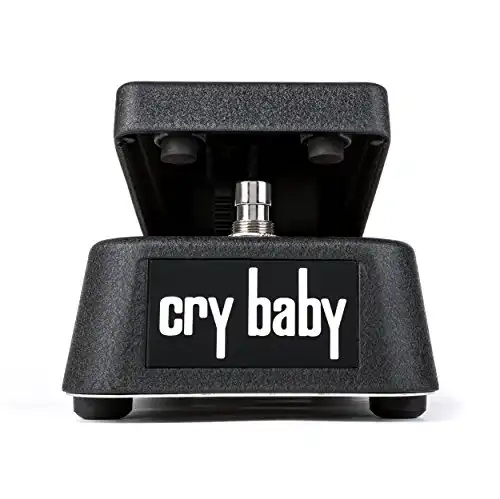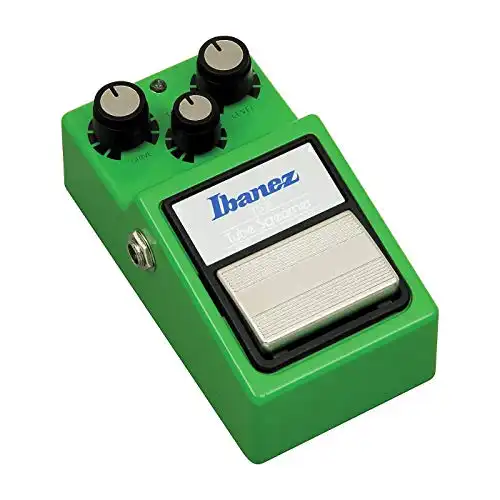An amplifier produces basic metal tones when it runs on high treble, high bass, and low mid-range frequency settings.
Since tone quality varies from one metal subgenre to the next, it’s always advisable to adjust the settings until you get a well-defined metal tone.
To help you get your desired tone, I’ll give you an insight into the best metal amp settings.
4 Settings All Amps Share You Need to Know When Playing Metal
1. Basic Metal Settings
Basic metal amp settings include distortion effects, high bass, high treble, and low mid-range frequencies. The end result of such settings is a heavy and well-defined metal tone. Here are some of the settings that are ideal for a basic metal tone:
- Bass: 7
- Gain: 8
- Volume: 4
- Treble: 7
- Mids: 4
It’s easy to adjust the settings slightly, based on your skills, until you find the tone that suits you best.
2. Classic Metal Settings
If you love classic metal music from the ’80s by Iron maiden, Mötley Crüe, or Dio, I’d recommend these settings:
- Bass: 6
- Gain: 7
- Volume: 6
- Treble: 5
- Mid-frequencies: 6
When it comes to classical metal tone settings, the distortion effects are much stronger than the ones on a basic metal tone.
For example, James Hetfield, Metallica’s guitarist, used high gain options ranging from 7 to 9 on most songs.
However, the gain should be cut back on modern high-gain amps. Too much gain reduces the tone clarity.
In the ’70s and ’80s, amps did not feature high-gain options. So, it’s always advisable to cut back the gain on new modern amps.
If you don’t want to get muddy tones while playing your guitar, reduce the bass a touch. Also, keep it above the midpoint, just like James Hetfield did in the ‘80s. He preferred a bass frequency setting of 6.
Moreover, the mids were slightly boosted—between 6 and 7—to bring out that classic metal music character.
3. Nu Metal Settings
To produce Nu metal tones in the vein of Korn or Limp Bizkit, use these settings:
- Bass: 5
- Gain: 6
- Volume: 4
- Treble: 6
- Mids: 5
These are effective in bringing out the rhythmical aspects of Nu metal songs or tracks. And instead of focusing on metal thrash sounds, Nu metal settings generate guitar tones with good clarity.
While the gain should be slightly above the midpoint, popular guitarists and bands usually opt for varying gain options.
For instance, Wes Borland has an explosive style that’s characterized by thick tonalities and ringing notes, as a result of high-gain options.
By pushing the gain settings to 6 or 7, you’ll get thick tones, identical to Wes Borland’s style.
However, high-gain options can increase the noise produced by strings. So, I’d advise you to dampen and balance your tones with light palm muting. Also, mids have to be cut back slightly to 5 or 4.
Linkin Park, on the other hand, prefers distorted tones, which are warm, smooth, and rather thick. The band relies on high-gain options, ranging from 8-10. Additionally, bass settings are always pushed to 7, while mids are maintained in the middle, between 5 and 6.
If you want to nail Linkin Park’s Nu metal tones, turn your knobs to:
- Bass: 7
- Gain: 8
- Treble: 6
- Mids: 5
4. Thrash Metal Settings
Here are some of the most effective thrash metal settings:
- Bass: 7
- Gain: 8
- Volume: 5
- Treble: 6
- Mids: 3
Thrash metal music features low-register guitar riffs (bass riffs) and heavy rhythms. Cranking up the bass is an easy way of producing a chunky tone with a solid, thrash metal bass punch.
With that said, your amps’ bass settings should not be in the same frequency range as other band instruments. Differentiating sounds within the same frequency range is challenging. So, opt for a distinct frequency while adjusting the amp’s bass.
Of all the tones that have been listed here, thrash metal has the most cut-back mids. Scooped mids tightens thrash metal tones by cutting back the tones’ fullness.
As a result, the tone clarity is always preserved and maintained, as you switch from one note to the next while playing guitar.
Special Settings that May Be Unique to Your Amp
Orange Amp Settings
Featuring two different channels, most Orange amps have tons of options for processing input signals to generate varying tones. An example of an amplifier with easy-to-use controls is the Orange Crush.
Thanks to the dirty channel that processes metal tones, you’ll have an easy time while modifying distortions and the volume of different tones.
And if you are not familiar with metal amp settings, it is always advisable to rely on the easy-to-use functionalities.
The Orange Crush also gives you total control over equalization options such as bass, treble, and mid-frequency settings.
Speaking of which, you should adjust the EQ controls according to these settings:
- Bass: 6
- Gain: 7
- Reverb: 3
- Treble: 6
- Mids: 5
The Orange Crush gives you total control over equalization options such as bass, treble, and mid-frequency settings.
2. Yamaha THR10 Settings
While Yamaha THR10 comes with five channels, the most suitable channel for processing metal tones is the ‘Modern’ channel.
Here are the ideal settings for a metal tone:
- Bass: 8
- Gain: 5
- Treble: 8
- Master: 5
- Mids: 4
The THR10 sounds great in a wide range of genres, whether played delicately with a clean sound, or with a more edgy, distorted tone
How to Set Your Amp to Shred
1. Use Deep Bass Settings
Metal music is characterized by deep bass with a lot of depth. If you want to get good and deep bass, opt for a high bass setting, ranging from 7-8.
High bass settings are quite effective in adding some punch to the metal tone and getting rid of tone thinness.
The bass produced by an amp also depends on the gain settings. If your amp is running on a high-gain option, it’ll produce more bass. When an amp has a low gain setting (2-3), the bass might not be well-defined.
If you analyze most metal amp settings, you’ll notice that the gain is always maintained in the same range as the bass to create a perfect balance.
However, finding the perfect balance between bass and other frequencies can be rather challenging on some metal tones.
In some instances, the bass might be too high, such that it overpowers other frequencies. The best thing to do in such a scenario is to cut back the bass to a rather high low-end setting, ranging from 5-6.
While amplifiers can generate a hefty bass sound, some amps cannot produce a solid bass sound.
2. Keep The Gain High
To add character to metal tones, use a high-gain setting on your amp. Good metal tones are often produced by an amp with a high gain setting, between 7 and 8. If you are using a metal amp with extra sensitive gain options, I’d advise you to cut back on the gain. Keep the gain control between 5 and 7.
A lot of gain increases the bass output, producing some muddy tones.
The gain also differs, depending on the type of amplifier that you might be using. For instance, a solid-state amp requires a maximum level setting to produce good metal tones.
3. Increase The Treble
Your amp’s treble control should be between 7 and 8, as you are playing metal music. High treble makes a metal tone much clearer by producing well-defined riffs.
4. Lower Your Mids
Metal tones sound more balanced with ‘scooped mids’, so you have to keep the mids below bass and treble frequencies.
The most effective mid-frequency setting is a 4. However, you can work your way up, especially on thin tones. Cranking the mids to 5 will patch up tones that sound thin. Plus, some tones sound better with high mids.
For example, classic metal tones sound better with higher mids, balanced between 4 and 5.
While everything really boils down to the type of metal tone that you are planning to get, I’d recommend starting with mids that range between 4 and 5.
And if your amp has a contour control knob, crank up the knob to 6 or 7. As the contour increases, the mids will be toned down. Cranking the contour knob to a 6 or 7 is a simple technique for scooping the mids.
5. Use A Distortion Pedal
A distortion pedal extends the functionality of your amp by boosting an audio signal to its maximal level, producing overtones.
You need to use a distortion pedal if your amp doesn’t have powerful gain features.
3 Most Popular Guitar Pedals for Metal Guitar
MXR Phase 90
The MXR Phase 90 came to the limelight due to Eddie Van Halen, one of the most renowned classic metal guitarists.
According to Van Halen, MXR Phase 90 produces a unique and warm tone, with a subtle phase sweep effect.
If you’re planning to get a classic, warm, and subtle metal tone, I would recommend this amp. Songs like ‘Drop Dead Legs,’ ‘Ain’t Talkin Bout Love,’ and ‘Eruption’ will sound good with the MXR Phase 90.
MXR Phase 90 produces a unique and warm tone, with a subtle phase sweep effect.
Thanks to this pedal, Eddie Van Halen formulated a signature metal tone—the Brown Sound.
The sound is characterized by high distortions and high-gain effects, complemented by a rather powerful warm tone.
You’ll nail Van’s metal tones by turning the phasers knob to the 9 O’clock position and adding a delay effect.
2. Dunlop Cry Baby Wah
As the name hints, the Dunlop Cry Baby is quite effective in producing the ‘wah’ effect.
The effect is produced when a guitar generates a “waaah” sound, similar to the one generated by humans while uttering the word ‘waah’.
For smooth Wah effects, the Dunlop Cry Baby might be an effective pedal for you.
Eric Clapton and Jimi Hendrix are some of the guitarists that used the Dunlop Cry Baby to create classic metal tones.
For example, ‘Voodoo Chile’ by Jimi Hendrix is a song that has multiple effects, which were generated by the Dunlop Cry Baby.
The Dunlop Cry Baby is quite effective in producing the ‘wah’ effect. The effect is produced when a guitar generates a "waaah" sound, similar to the one generated by humans while uttering the word 'waah'.
3. Ibanez Tube Screamer
As an overdrive pedal, the Ibanez Tube Screamer was developed to magnify mids and deliver them with a punch. It also balances mids in heavily distorted tones, reducing the overall muddiness.
Try the Ibanez Tube Screamer if you are struggling with muddy metal tones.
Thanks to Stevie Ray Vaughan, the Ibanez Tube Screamer became popular in the rock music genre. Once Stevie Ray started using the Ibanez Tube Screamer, guitarists like John Mayer and Gary More followed suit.
The Ibanez Tube Screamer was developed to magnify mids and deliver them with a punch. It also balances mids in heavily distorted tones, reducing the overall muddiness.
Chug On
Did you enjoy getting insight into the most popular metal amp settings?
These will make it much easier for you to play metal songs without getting muddy or over-saturated tones.
But, you have to crank the bass, gain, and treble to high-level settings ranging from 6 – 8, depending on the sub-genre. Afterward, balance the frequencies by maintaining the bass in the same range as the gain.

